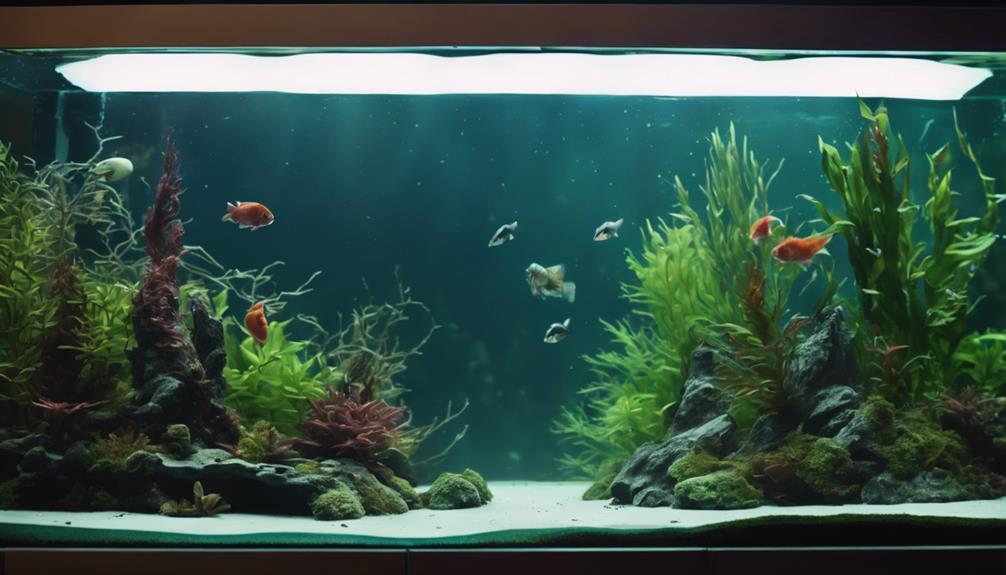You're likely familiar with the challenges that uncontrolled algae growth can pose to industrial processes and environmental ecosystems, but what if you could leverage innovative algae control products to not only mitigate these issues but also tap into new opportunities for renewable energy and sustainable practices? Algae control products have the potential to revolutionize industries, from biofuels and animal feed to wastewater treatment and climate change mitigation. By understanding the unique characteristics of different algae types and utilizing non-toxic methods like ultrasound technology, you can tap into the vast potential of algae-based solutions and discover new ways to drive sustainability and growth.
Table of Contents
Key Takeaways
- Algae control products prevent uncontrolled algae growth that can clog equipment and disrupt production processes, reducing industrial downtime.
- Effective algae control measures enable the use of algae for biofuels, animal feed, and nutritional supplements, promoting sustainable industrial practices.
- Non-toxic algae control methods like ultrasound technology minimize harm to aquatic life, ensuring a healthy ecosystem and promoting environmental sustainability.
- Algae control products support the growth of algae for environmental remediation, such as purifying water by removing excess nutrients, reducing greenhouse gas emissions.
- Innovative algae control technologies like the Quattro-DB ultrasonic system provide a cost-effective and efficient solution for larger ponds and lakes, making them a game changer.
The Algae Advantage
By leveraging algae's unique characteristics, you can create innovative solutions that address various environmental and industrial challenges.
One such solution is the Algae Control Device, which utilizes ultrasound technology to stimulate the growth of beneficial bacteria. These microorganisms play a vital role in breaking down organic matter and maintaining a balanced ecosystem. By promoting their growth, you can naturally control algae blooms and prevent the negative impacts they've on aquatic environments.
When it comes to industrial applications, algae can be used to produce biofuels, animal feed, and nutritional supplements. However, uncontrolled algae growth can clog equipment and disrupt production processes.
The Algae Control Device helps mitigate this issue by maintaining a perfect balance of algae and beneficial bacteria. This results in increased efficiency, reduced maintenance costs, and a more sustainable operation.
Understanding Algae Types
When controlling algae growth, it's vital to determine the specific type of algae present in your pond, as different species respond differently to various control methods.
There are thousands of distinct types of algae, but understanding the main groups – microalgae (single-celled) and macroalgae (multicellular) – is essential.
Microalgae can thrive in salt or freshwater, while macroalgae are classified into green, red, and brown types.
You'll also need to identify how the algae grow.
Do they form planktonic algae, floating in the water column, or do they grow as filamentous or string-like algae?
Each type requires a tailored approach to control.
For instance, methods effective against planktonic algae mightn't work on filamentous algae.
To accurately identify the type of algae in your pond, you may need to take an algae sample or conduct testing, as visual examination alone is often insufficient.
Bioenergy and Biofuels Potential

As you explore the domain of bioenergy and biofuels, you'll find that algae-based solutions are gaining traction.
You're likely to discover that algae biofuels have the potential to make a significant impact on the aviation industry, and that growing algae biomass can provide a renewable energy source.
Algae Biofuels Potential
Algal biomass is being explored as a promising feedstock for biofuels, offering a potential alternative to traditional crops.
As you dig deeper, you'll discover that algal biofuels have the potential to reduce emissions by using E10 or sustainable aviation fuel, providing a cleaner alternative to traditional fossil fuels. Growing algae for biofuels can be done on marginal land, reducing competition with food crops and preserving precious agricultural land for food production.
The benefits don't stop there. Algal biofuels can provide a closed-loop system where CO2 from power plants is captured and utilized as a nutrient for algae growth, reducing greenhouse gas emissions.
This means you can contribute to a more sustainable future by supporting the development of algal biofuels. As demand for biofuels increases, driven by rising oil prices and climate change policies, it's crucial to explore innovative solutions like algal biomass feedstock.
Growing Algae Biomass
Growing algae biomass for bioenergy and biofuels production requires a controlled environment that maximizes factors like temperature, pH, and nutrient availability to maximize algal growth rates and lipid yields. You'll need to create an environment that mimics the natural conditions in which aquatic plants thrive.
This means providing the right amount of light, CO2, and nutrients for your algae to grow rapidly and efficiently.
To achieve this, you'll need to implement effective algae control measures, such as Ultrasonic Algae Control, to prevent contamination and maintain ideal growth conditions.
This technology uses high-frequency sound waves to prevent algae from forming, allowing you to focus on growing high-quality algae biomass.
By maximizing growth conditions and controlling algae growth, you can increase lipid yields and improve the overall quality of your algae biomass.
This, in turn, will enhance the viability of your bioenergy and biofuels production.
With the right strategies and technologies in place, you can tap the full potential of algae biomass and contribute to a more sustainable energy future.
Renewable Energy Source
By harnessing the potential of algal biomass, you can tap a renewable energy source that offers a low-carbon alternative to traditional fossil fuels, reducing greenhouse gas emissions and mitigating climate change.
Algae-based biofuels have the potential to power vehicles, airplanes, and other modes of transportation, providing a sustainable solution for the transportation sector.
With algae containing up to 50% oil by weight, they're an attractive feedstock for biodiesel production.
Furthermore, using algae as a feedstock for biofuels reduces land use competition, as they can be grown on non-arable land or in aquatic environments, freeing up land for food production and preserving biodiversity.
The global algae biofuels market is projected to reach $10.7 billion by 2025, driven by increasing demand for sustainable energy sources and government incentives for renewable energy development.
By investing in algae control products, you can be part of this growing industry, contributing to a cleaner, more sustainable future.
With algae-based biofuels, you can reduce greenhouse gas emissions by up to 80% compared to traditional fossil fuels, making them a game-changing renewable energy source.
Livestock Feed and Climate Change
As the livestock industry continues to grapple with its significant environmental footprint, innovative solutions like FutureFeed are emerging as a viable way to reduce methane emissions and combat climate change. You might be wondering how this works. The answer lies in the unique properties of Asparagopsis seaweed, which contains bioactives that disrupt the normal processes that lead to methane gas formation.
Here's a breakdown of the impact of methane emissions and the benefits of using FutureFeed:
| Emissions | Impact | FutureFeed Benefits |
|---|---|---|
| Methane | 28x warming potential of CO2 | Reduces emissions by >80% |
| Greenhouse gases | Contributes to climate change | Disrupts methane formation |
| Livestock feed | Contributes to emissions | Provides sustainable alternative |
| Ocean health | Maintains healthy seaweed ecosystems | Supports kelp forests as carbon removal systems |
Ultrasound Technology Breakthrough

You're about to discover a groundbreaking innovation in algae control: the Quattro-DB ultrasonic system, which offers a non-chemical, cost-effective solution for larger ponds and lakes.
This ultrasound system is a game changer, providing significant improvements over existing technology. Its denser frequency array guarantees better control of algae, and it's safe for fish and other aquatic wildlife.
After a year and a half of development, early testing indicates promising results in controlling blue-green algae.
What's more, the Quattro-DB system provides better cost vs coverage compared to existing technology, making it a cost-effective algae treatment for large ponds and multi-acre lakes.
As an innovative solution, it can be used in conjunction with other methods, such as aeration and beneficial bacteria supplementation, to improve pond health.
The Quattro-DB system is a step in the right direction, offering a promising solution for controlling algae in larger bodies of water.
With its non-chemical approach, it's an attractive option for those seeking a more environmentally friendly solution.
Limitations of Existing Systems
Existing ultrasound technology for algae control falls short in several key areas, hindering its overall effectiveness and necessitating the development of more innovative solutions.
You may have noticed that existing systems only achieve around 70% effectiveness, leaving room for improvement. Unfortunately, the technology hasn't seen significant advancements in recent years, making it clear that new solutions are needed.
In industrial settings, the cost vs coverage of existing systems is a major limitation, making them less effective for larger bodies of water.
Furthermore, you'll find that existing systems aren't effective against blue-green algae, which can turn toxic and pose a threat to aquatic life and human health.
This is particularly concerning, as effective algae control is vital for maintaining healthy ecosystems.
The limitations of existing systems highlight the need for more research and development to create more effective and efficient algae control products.
Effective Algae Control Methods

When you're looking for effective algae control methods, you'll want to weigh a range of options that prioritize both efficacy and environmental safety.
You'll find that non-toxic solutions, for instance, offer a promising approach that minimizes harm to aquatic life.
Meanwhile, cutting-edge technologies like ultrasonic systems are also being explored for their potential to control algae growth without causing collateral damage.
Algae Control Methods
Effective algae control methods, including ultrasonic systems, biological approaches, and mechanical techniques, offer a range of solutions to combat the proliferation of algae in various aquatic environments.
You've likely heard of ultrasonic algae control, which uses sound waves to kill or damage algae cells. This method has been used for over 15 years in ponds, lakes, and industrial settings, and systems like the Quattro-DB offer significant improvements over existing technology.
Biological approaches, such as using beneficial bacteria or enzymes, can break down organic sludge and reduce nutrients in the sediment. Mechanical techniques, like circulation and aeration, introduce oxygen to assist biological processes.
Combining these methods can provide a more thorough solution for pond health. For instance, ultrasound can stimulate beneficial bacteria activity without harming them. While ultrasonic systems may not be suitable for small ponds due to cost considerations, they can be a cost-effective solution compared to chemical and biological methods.
Non-Toxic Solutions
You're likely looking for an algae control solution that prioritizes the well-being of your aquatic environment, and non-toxic methods are becoming increasingly essential in this pursuit.
As the world shifts towards more sustainable practices, it's vital to adopt solutions that don't harm the environment. Non-toxic algae control products are a game-changer in this regard.
Non-toxic algae control methods offer several key benefits.
They prioritize the health and safety of aquatic wildlife, ensuring that fish and other organisms thrive in their natural habitats.
Non-toxic methods like ultrasound technology are highly effective in controlling algae growth, particularly in larger waters.
They offer a cost-effective solution compared to chemical and biological treatments.
Ultrasonic Technology
Over 15 years of research and implementation have proven ultrasonic technology to be a reliable and environmentally friendly solution for controlling algae growth in ponds, lakes, and industrial settings. You've likely heard of sound waves being used to clean surfaces, but did you know they can also be used to control algae growth? Ultrasonic algae control systems use sound waves at specific vibrational frequencies to kill or damage algae cells.
| Algae Species | Effectiveness | Notes |
|---|---|---|
| Microcystis | Highly Effective | Responds well to ultrasound |
| Anabaena | Highly Effective | Responds well to ultrasound |
| Spirogyra | Moderately Effective | Some resistance to ultrasound |
| Chlorella | Moderately Effective | Some resistance to ultrasound |
| Chara, Oscillatoria, Nitella, Euglena, Pediastrum, Cladophora | Not Effective | Resistant to ultrasound |
As you can see, ultrasonic technology is particularly effective against certain algae species. By using ultrasound in conjunction with other methods, such as aeration and beneficial bacteria supplementation, you can provide a thorough solution for pond health and algae control.
Future of Algae Biorefineries
As researchers continue to explore the vast potential of algae biorefineries, they're poised to revolutionize the way you produce fuel, oils, plastics, and nutritional products while mitigating environmental degradation.
Among thousands of species, certain types of algae can be harnessed to provide ingredients for a wide range of applications.
Algae biorefineries can help purify water by removing excess nutrients, making them a sustainable solution for environmental remediation.
They can provide a renewable alternative to fossil fuels, reducing greenhouse gas emissions and mitigating climate change.
Fundamental research is needed to realize the full potential of algae biorefineries, including developing more efficient and cost-effective methods for algae cultivation and processing.
If successful, algae biorefineries could play a significant role in reducing your reliance on fossil fuels and contributing to a more sustainable future.
As you consider the potential of algae biorefineries, it's clear that they hold the key to a more sustainable, environmentally-friendly future.
With continued research and investment, you can expect to see these innovative facilities playing a major role in shaping the future of production.
Frequently Asked Questions
Why Are People Switching to Algae Farming?
You're switching to algae farming because it offers a sustainable future, allowing you to harvest high-yielding algae while maintaining excellent water quality, which is essential for a thriving ecosystem and a guilt-free conscience.
What Are Three Reasons Why Algae Is a Beneficial and Clean Energy Source?
As you plunge into the world of algae, you'll discover it's a treasure trove of clean energy benefits, boasting immense biofuel potential, absorbing CO2 through carbon sequestration, and producing oxygen, making it an infusion of revitalization for our planet.
Is Algae Good or Bad for Climate Change?
You're right to wonder if algae is good or bad for climate change. On one hand, algae absorbs CO2, reducing climate impact; on the other, algae blooms can harm ocean health, so it's a complex, multifaceted issue.
How Effective Is Ultrasonic Algae Control?
You'll be surprised to know that 90% of lakes worldwide are affected by algae blooms. When it comes to ultrasonic algae control, you're leveraging sonar technology that utilizes wavelength adjustments and signal frequencies to target specific algae species, offering a precise and effective solution.
Conclusion
Algae control products are revolutionizing the industry.
By harnessing the power of microalgae, we're releasing sustainable solutions for bioenergy, livestock feed, and climate change mitigation.
With cutting-edge ultrasound technology and effective control methods, the future of algae biorefineries looks brighter than ever.
As we continue to navigate the complexities of algae cultivation, one thing is clear: the potential for positive impact is vast, and the time to tap into it's now.

